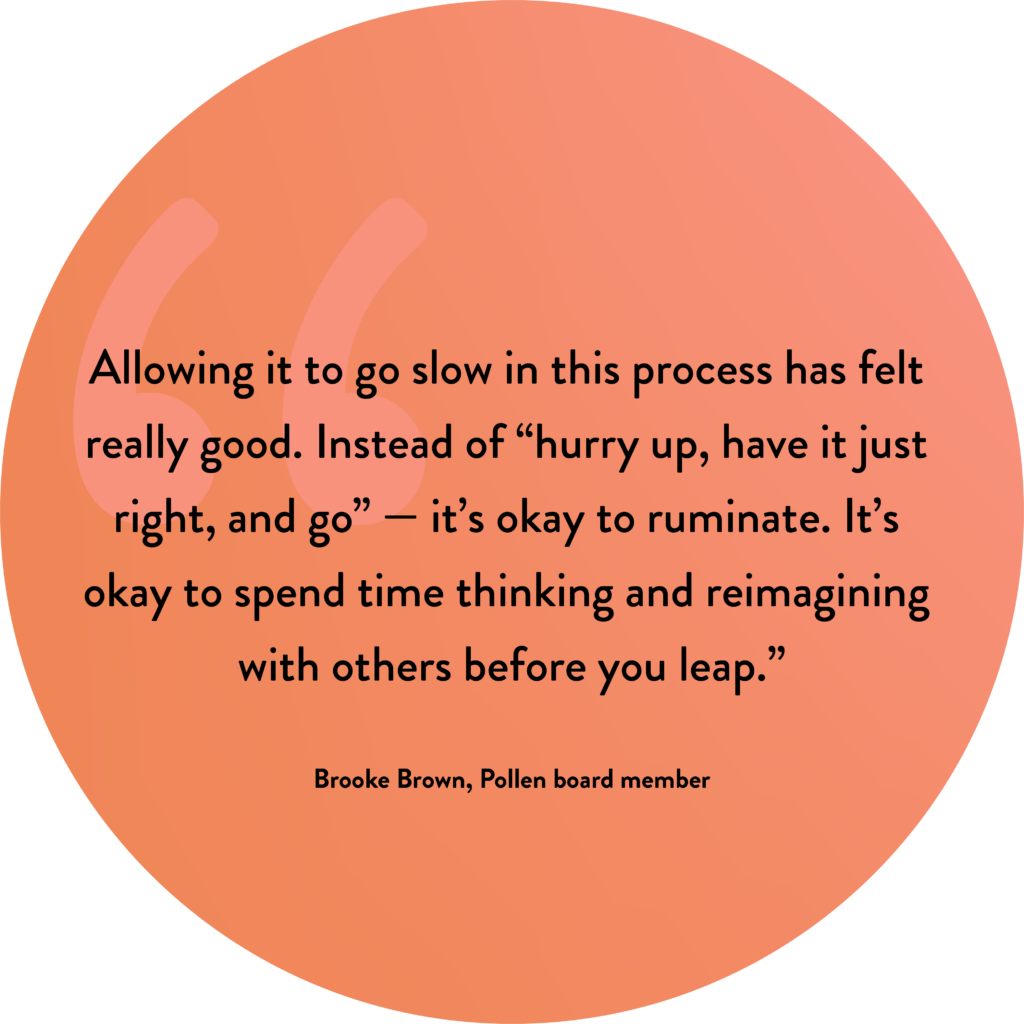
By: Jamie Millard
As Pollen continues through our Executive Director leadership transition (read about that here), every other week we will share more about our process, reflections, takeaways, and updates. “Bloom: Pollen’s Growth & Executive Director Transition Series” will candidly share how we’ve approached our process of executive leadership transition — a process that centers transparency, prevents harm, and is rooted in racial equity.
In our previous article, we shared how the goal of building deep solidarity and trust between staff and board became Pollen’s first guiding principle in our executive director transition. Once we built alignment between staff and board, helped by the formation of our Leadership Expansion Working Group, we were ready to dig into this work.
In this article, we’ll focus on how we used that foundation of trust to get clear about our “how” by asking the question: What matters most?
It’s a simple question, but the answers can provide a guiding compass for big and small decisions.
For Pollen, one of the central answers that surfaced for us was: How we do this leadership transition matters.
When Pollen set out to determine our leadership transition framework, the “Why” and the “What” were pretty clear.
- Why we are doing this: To build on past growth and move into our next evolution as leaders in narrative change by sharing stories, art, and connections to help us imagine a better, more just future.
- What our outcome will be: A new organizational structure and an executive director leadership transition that builds on current strengths while also furthering us as experts in the methodology of narrative change to imagine this better future.
But we knew our real opportunity to make this process feel right for Pollen would be in our how.

The “How” Matters
If you Google “nonprofit succession plan,” the results are a little underwhelming. All of the key steps are pretty standard, but what’s missing is guidance on how an organization’s unique culture and values can inform the process.
The “how” goes beyond just the process and steps, it holds the guiding values, the behaviors, the emotions that live underneath the process. A strong “how” is where your commitments thrive.
Pollen set out to define our own “how” for our executive director succession planning. This simple guiding statement would help us navigate an emergent process that centered our values at every decision point:
How this transition will happen: We will center our values of racial justice and trust, and together our board and staff can imagine new ways to evolve through leaderships transitions.
There are three main values housed within this statement:
1. A commitment to racial justice.
2. A commitment to building trust.
3. A commitment to imagining new ways to evolve through leadership transition.

What Matters Most
Finding the right answers to big questions tends to uncover more truths—and that held true for Pollen in this process. A clear statement of intent for our “how” led us to some related priorities, all blossoming from that foundational understanding of what mattered most to us.
- Setting up the next executive director for maximum success.
- Nurturing current staff during this process of transformation.
- Creating a process that leads our staff and board towards even greater trust and connection.
- Removing urgency as a factor in our planning. We can be thoughtful and committed to progress.
- Learning from transitions in other nonprofits/sectors.
- Sharing our process and being transparent internally and externally.
Even as we move through this process, we’re still working on the “how”—taking our time, being intentional, and making sure we’re keeping those commitments centered at every step.

Action steps we took:
- Looking back: Pollen revisited our organizational history of past transformations to discuss patterns and insights that might help inform our behaviors and approach for this transition.
- A question prompt to consider: “When has your organization gone through transformation before? How did the transformation take place? What worked well, what could be different?”
- Grounding: We began every leadership transition related meeting with a regrounding on our Why, How, and What.
- Research: Knowing that we wanted our “how” to involve imagining new ways to evolve through leadership transition, this would mean prioritizing learning and researching how others have gone through this process in different ways. As a staff and board, we spent time reading articles, attending webinars, and learning form the nonprofit leadership transition field.
- Embodied listening: Reminding ourselves that our “how” is not just a process but also the behaviors and emotions present during a process. This requires frequent pause to listen to our intuition and felt senses, and to double check that we’re operating within our prioritized values.

What’s up next in “Bloom: Pollen’s Growth & Executive Director Transition Series”
Stay tuned for our next installment on September 28.
